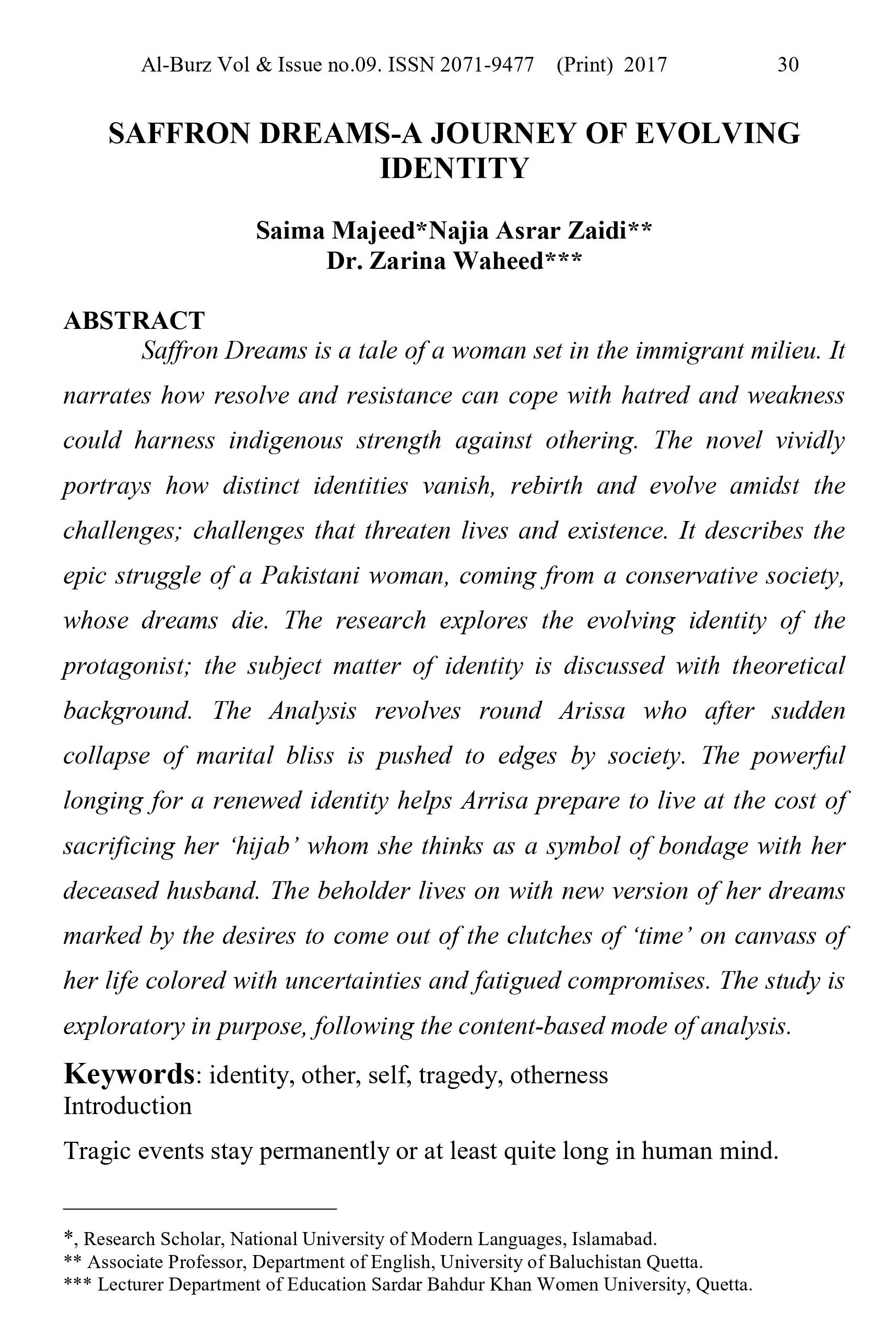SAFFRON DREAMS-A JOURNEY OF EVOLVING IDENTITY
DOI:
https://doi.org/10.54781/abz.v9i1.102Keywords:
identity, other, self, tragedy, othernessAbstract
Saffron Dreams is a tale of a woman set in the immigrant milieu. It narrates how resolve and resistance can cope with hatred and weakness could harness indigenous strength against othering. The novel vividly portrays how distinct identities vanish, rebirth and evolve amidst the challenges; challenges that threaten lives and existence. It describes the epic struggle of a Pakistani woman, coming from a conservative society, whose dreams die. The research explores the evolving identity of the protagonist; the subject matter of identity is discussed with theoretical background. The Analysis revolves round Arissa who after sudden collapse of marital bliss is pushed to edges by society. The powerful longing for a renewed identity helps Arrisa prepare to live at the cost of sacrificing her ‘hijab’ whom she thinks as a symbol of bondage with her deceased husband. The beholder lives on with new version of her dreams marked by the desires to come out of the clutches of ‘time’ on canvass of her life colored with uncertainties and fatigued compromises. The study is exploratory in purpose, following the content-based mode of analysis.
References
Abdullah, S. Saffron Dreams: A Novel vol. 5, Loving Healing Press, 2009. p.
Ashraf, R. "An Optimistic Evolution of Existence in Saffron Dreams by Shaila Abdullah." Language in India, vol. 15, no. 6, 2015, p. 15, http:www.languageinindia.com/june2015/rabiathesisfinal.pdf.
Baggini, J. "Jean-Paul Sartre: Existentialism and Humanism (1947)." Philosophy: Key Texts, 1 edition, Palgrave Macmillan, 1948, pp. 115-133. http://www.palgrave.com/in/book/9780333964859?wt_mc=ThirdParty.SpringerLink.3.EPR653.About_eBook.
Bates, T. R. "Gramsci and the Theory of Hegemony." Journal of the History of Ideas, vol. 36, no. 2, 1975, pp. 351-366, https://ondercetin.files.wordpress.com/2011/04/bates-1975.pdf.
Brons, L. L. "Othering, an Analysis." Transcience, a Journal of Global Studies, vol. 6, no. 1, 2015, pp. 69-90, https://philpapers.org/archive/BROOAA-4.pdf.
Buyze, D. M. Cultural Taste & the Postcolonial Other. 2005. http:Slought.org, November 2013.
Cheng, M. and S. L. Berman. "Globalization and Identity Development: A Chinese Perspective." New directions for child and adolescent development, vol. 2012, no. 138, 2012, pp. 103-121, doi:10.1002/cad.20024.
Colbert, J. G. and J. V. Femia. "Gramsci's Political Thought: Hegemony, Consciousness, and the Revolutionary Process." vol. 33, no. 3, 1986, pp. 230-232, http://www.jstor.org/stable/20100173.
Cote, J. E. and S. J. Schwartz. "Comparing Psychological and Sociological Approaches to Identity: Identity Status, Identity Capital, and the Individualization Process." Journal of adolescence, vol. 25, no. 6, 2002, pp. 571-586.
Elkind, D. "Erik Eriksons Eight Ages of Man: One Man in His Time Plays Many Psychosocial Parts." New York Times magazine, 1970, pp. 150-157, https://www.pdx.edu/sites/www.pdx.edu.ceed/files/sscbt_EriksonsEightAgesofMan.pdf.
Gill, S. Gramsci, Historical Materialism and International Relations. vol. 26, Cambridge University Press, 1993. p.
Goffman, E. "The Presentation of Self in Everyday Society." Garden City, 1959, http://www.public.iastate.edu/~carlos/607/readings/goffman.pdf.
Kuryla, P. "Barack Obama and the American Island of the Colour Blind." Patterns of Prejudice, vol. 45, no. 1-2, 2011, pp. 119-132, http://www.tandfonline.com/doi/abs/10.1080/0031322X.2011.563150.
Leary, M. R. and J. P. Tangney. Handbook of Self and Identity. Guilford Press, 2012. p.
McAdams, D. P. and C. Zapata-Gietl. "Three Strands of Identity Development across the Human Life Course: Reading Erik Erikson in Full." The Oxford handbook of identity development, 2015, pp. 81-94.
Mead, G. H. "Mind, Self and Society." University of Chicago Press, 1934, pp. 1-20. The Classic Traditions,http://people.wku.edu/steve.groce/mindselfandsociety.pdf.
Meeus, W. "The Study of Adolescent Identity Formation 2000–2010: A Review of Longitudinal Research." Journal of research on adolescence, vol. 21, no. 1, 2011, pp. 75-94, doi:10.1111/j.1532-7795.2010.00716.x.
Omi, M. and H. Winant. Racial Formation in the United States. Routledge, 2014. p.
Raja, M. A. Constructing Pakistan: Foundational Texts and the Rise of Muslim National Identity 1857-1947. Oxford University Press, 2010. p.
Roychoudhary, M. et al. "Dismantling Patriarchy: Postcolonial Theme in the Short Stories of Namita Gokhale and Shaila Abdullah." vol. 4, no. 4, 2016, pp. 30-35, www.ijells.com.
Sheridan, L. P. "Islamophobia Pre and Postseptember 11, 2001." Journal of interpersonal violence, vol. 21, no. 3, 2006, pp. 317-336.
Shryock, A. Islamophobia/Islamophilia: Beyond the Politics of Enemy and Friend. Indiana University Press, 2010. p.
Smokowski, P. R. and M. L. Bacallao. "Acculturation and Aggression in Latino Adolescents: A Structural Model Focusing on Cultural Risk Factors and Assets." Journal of Abnormal Child Psychology, vol. 34, no. 5, 2006, p. 661

Downloads
Published
How to Cite
Issue
Section
License
Copyright (c) 2017 Authors who publish with Al-Burz journal agree to the following terms: 1. Authors retain copyright and grant the journal right of first publication with the work simultaneously licensed under a Creative Commons Attribution (CC-BY) License that allows others to share the work with an acknowledgement of the work's authorship and initial publication in this journal. 2. Authors are able to enter into separate, additional contractual arrangements for the nonexclusive distribution of the journal's published version of the work (e.g., post it to an institutional repository or publish it in a book), with an acknowledgement of its initial publication in this journal.

This work is licensed under a Creative Commons Attribution-NonCommercial-ShareAlike 4.0 International License.
Alburz has licensed under a CC Attribution-NonCommercial-ShareAlike 4.0



